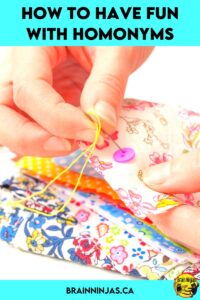
Do your students struggle with using the correct word when they are writing? Do homophones confuse your students when they are reading? They are not alone. There are more than six thousand different homophones in the English language. No wonder it’s so confusing for students.
Teaching homophones and homographs can be a lot of fun. We’ve collected some of our favourite lessons, books and activities that you can use in your classroom to practice using homonyms. Come read more!
What are Homophones, Homographs and Homonyms?
Homophones are words that sound the same, but they have different meanings and different spellings. Homographs are spelled the same, but they have different meanings and pronunciations.
Homonyms can be either or both, depending on the word.
This difference is usually only for the teacher to know. In our classroom, we refer to them as homonyms for the most part. We don’t require our students to know the difference, but we do explain there are differences.
Lessons to Teach Students About Homonyms

A good place to start is to explicitly teach students about homographs and homophones. We created an interactive notebook lesson that will help your students learn the differences between different types of homonyms. This lesson set also comes with different activities to practice the pronunciation, spelling and meanings of different homonyms. This includes a set of task cards that can be used on paper, using Google Slides or a self-marking version that uses Google Forms. Find Homophones & Homographs Lesson and Activities in our TpT Store ($USD) or BN Shop ($CAN).
If you’re looking for a fun game that practices the meanings of different homophones and homographs, you might be looking for our Homophones Bingo Game. It comes with thirty different game cards. Students will have to listen to each word in a sentence to determine which word on their card is being said. It is a fun challenge with a low risk for learners. Find Homophones Bingo on TpT ($USD) or our BN Shop ($CAN).
Create Your Homographs Own Game
We created this simple Word Bingo template. It’s basically a blank table where students can add any words. You can find it in our Resource Library, or we can send it directly to your inbox when you sign up for our email list.
Ask students to make a list of homographs and list these on a whiteboard or piece of chart paper. Have students fill in their template with different words from the list. Number the items on the list. Use this free random number picker to select one of the words.
Practice With Task Cards
Give your students a chance to practice using different homophones in the context of sentences. We have made decks of task cards. Each set comes with three decks. Each deck has 24 cards. The sets can be printed in colour or ink-saving versions. We have also included a Google Forms version with loose text that can be read by your assistive technology and a Google Forms version that can mark it for you.
Find Common Homophones Task Cards Set 1 on TpT ($USD) or our BN Shop ($CAN). We also have Common Homophones Task Cards Set 2 in our TpT Store ($USD) or in our BN Shop ($CAN).
Draw Them Out
Have students take a piece of paper and fold it in half. On one side, they can draw the definition of a homonym. On the other side, they can draw another spelling or pronunciation of it.
For example, if students choose whine/wine. On one side, they could draw a person crying with a speech bubble of a complaint or whine. On the other side, they could draw a glass of wine or grapes or a bottle to show wine.
If they choose a homophone like wind, they can do the same thing. One side could show a thread being wound on a spool. The other side could show the wind blowing a flag.
You can keep this simple by just sketching them out on paper or a whiteboard. Or, you can make it a little fancier by having students colour and display them.
Hunt for Homonyms While You Read

Read your students a book. Nearly any fictional book will work, but if you’re looking for one specifically with homonyms, we’ve included a list below.
There are two ways to do this.
Students can raise a hand (or some other indication) when they hear a homonym. You can write it as it appears in the text, and then the class can list any other ways it is spelled or pronounced.
Students can write the list on their own while they listen. At the end of the book (or a few pages in), you can ask students to read their lists and compare them with the rest of the class.
Homophone or Not
Using real homophones and some made-up ones, see if your students can find the fakes. You will need a list of homophones and then will need to be a little creative before starting. We’ve included a short list here.
Decide how your students will indicate if a word is real or not. A simple thumbs up or thumbs down will work, but you should welcome suggestions from your students.
Read out the words in each list one by one, asking students to indicate each one. When they find the fake, ask them to explain why it’s fake. Most of the time, it will just be the spelling, but if you’re really creative, you might find a new wrong way to pronounce a word.

We have put the fake words in bold. Not all of these will have a fake word (because we can’t make it too easy).
bye/buy/by/bie
so/sew/sow/soh
jam/jamb
boat/bote
there/their/they’re/thare
sign/syne
four/for/fore
hoarse/horse/horss
links/lynx/linx
rye/wry/ri
You can also play a variation of this game where the fake homophone is a real word but not a homophone for the first ones. This can be really helpful for students who have challenges with decoding or encoding words. Here are some examples that could work.
there/their/they
bare/bear/bar
care/car
brake/break/beak
four/for/far
Memorization Game
Give students index cards or pieces of paper that are cut to the same size. Have students write pairs of homophones one at a time on the card. For words that have several homophones, we limited our students to two so that they could be easily paired up.
Once there is a set of 10-20 cards, mix them up and place them face down. One student will flip two cards face up. If they match, the student keeps the cards and takes another turn. If they don’t match, they are placed face down in the same spot, and the other player starts their turn.
This can be fun if small groups of students make sets and then exchange them with other groups.
Take it a step further by having students explain the meanings of the cards when they find a match.
Books Full of Homonyms

Our book recommendations do not contain affiliate links. We would prefer that you shop from your local bookstore. Many local shops have discounts for teachers or schools. Most will order books or help you find them. Shopping local helps support your local economy.
Dear Deer: A Book of Homophones by Gene Barretta
How Much Can a Bare Bear Bear? by Brian P. Cleary
Crane & Crane by Linda Joy Singleton
If You Were a Homonym Or a Homophone by Nancy Loewen
A Chocolate Moose for Dinner by Fred Gwynne
Zoola Palooza: A Book of Homographs by Gene Barretta
Did You Say Pears? by Arlene Alda
Eight Ate: A Feast of Homonym Riddles by Marvin Terban
Aunt Ant Leaves Through the Leaves: A Story with Homophones and Homonyms by Nancy Coffelt
The Bat Can Bat: A Book of True Homonyms by Gene Barretta
No Reading Allowed: The WORST Read-Aloud Book Ever by Chris Carpenter and Lushlife
Llamaphones by Janik Coat
They’re There on Their Vacation by Brian P. Cleary
The King Who Rained by Fred Gwynne
You Loves Ewe! by Cece Bell
Scholastic Pocket Dictionary of Synonyms, Antonyms, Homonyms by Scholastic
A Bat Cannot Bat, a Stair Cannot Stare: More about Homonyms and Homophones by Brian P. Cleary
Looking for Other Ideas to Teach English Language Arts?
- How to Add Some Meat to Your Idioms Lessons
- Give Your Reading Instruction an Easy Twist
- How to Teach Reading With Book Clubs
- Research Skills: How to Teach Text Features
- How to Celebrate Poem in Your Pocket Day
- How to Teach Research Skills With Google Search
- Practical Strategies for Reluctant Readers
- Help! I Don’t Know How to Do Guided Reading
- Add Great Content to Your Literacy Lessons
- Challenge Your Students with Writing Activities Every Day
- 22 Amazing Ways to Use Word Wall Words
What other ways are you teaching your students about homonyms? Let us know in the comments below.







